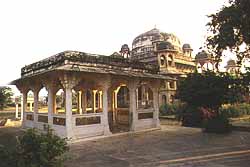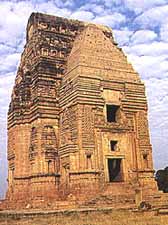Gwalior is named after a saint who cured the local chieftain Suraj Sen from leprosy. History of Gwalior dates back to 8th century. From then onwards Gwalior was to become the cradle of dynasties. This city gained glory as the time passed and today it stands amidst its past splendour. The massive fort which overlooks the city is a testimony to its glory and grandeur. This splendid city saw warrior kings, poets, musicians and saints who contributed in making Gwalior a city the way it stands today.
 |
Gwalior is one place which was most affected during the
Revolt of 1857. It was one centers which experienced fierce encounters between the British
and the 'Rebels'. The Maharaja of Gwalior was loyal to the British during the mutiny but
his troops sided with the rebels who had laid their hands on the city. Towards the end of
mutiny, Gwalior was subject to heavy fighting, after which British gained complete control
over India. Among those who laid down their lives here in their attempt to capture the
fort were Tatiya Tope and Rani of Jhansi. Pictograph 1 - Tansen's Tomb |
Gwalior changed hands from the Tomars to Lodhis of Delhi. Then it was ruled by the Mughals and finally the Marathas laid their hands on this city. Each era and rulers left their impression on this city but what remained unchanged and unphased was the imposing fort which withstood any assault on Gwalior. Even today thick walls and high ramparts of the fort seem invincible. Gwalior is a city where the rich cultural tradition blend with modern life, where the princely past lives in palaces and museums, past mixes with present to offer visitor a city of enduring greatness.
| Gwalior is barely 321 kms from Delhi and is
well connected by Air, Rail, Road services. This city has its own airport and the airlines
operating in India provide their services to this city. Flights connect Gwalior with the
other cities of India. On the railway route Gwalior is major a station with many superfast
and express trains having a stopage at Gwalior station. This beautiful station receives
Shatabdi trains and the Royal Palace on Wheels. By road also this city is linked
with other cities in India. The state transport and private bus operators have their
services not only to the nearby places but also to places outside the state. There are bus
services to Chandigarh and Lucknow too. Pictograph 2 : A Gwalior Temple -->> |
 |
Tomb of Tansen - Father of Indian classical music and one of the
nine Gems in Akbar's court is buried in Gwalior. The memorial of this great singer
carriers a very simple tone in itself and is surrounded by gardens on its sides. This
monument is a part of Gwalior's cultural heritage. Every year a music festival is
organised here. The festival is held in November / December and attracts singers and
musicians from all over India.
Mausoleum of Ghaus Mohammed - Ghaus Mohammed, whose sand stone mausoleums is laid
in the old town of Hazira, was a Afghan Prince turned sufi saint who had helped Babur to
win the Gwalior fort. His mausoleum is designed on early Mughal architectural lines.
Particularly exquisite are the screens using pierced stone technique. The carvings on
these screens are as delicate as lace.
Sun Temple - This newly constructed temple is based on the lines of the Konark
temple. It is located near the Residency at Morar.
information written & Compiled by Anurag Prasad
For travel.indiamart.com